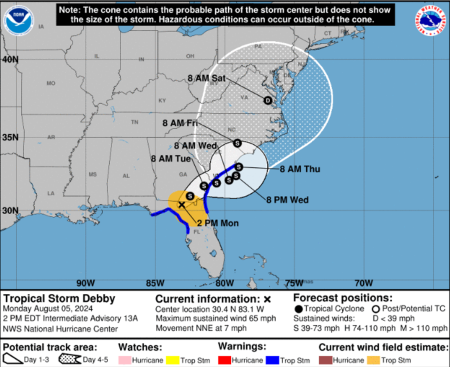Tropical Storm Debby tracker: 'Potentially historic rainfall' could bring 'catastrophic flooding'

Residents living along the East Coast of the United States have been urged to evacuate as Tropical Storm Debby is expected to bring historic rainfall to the region.
The storm made landfall on the Gulf Coast of Florida on Monday. The National Hurricane Center's projected path shows that it is expected to linger off the coast of the southeastern United States, hovering over Georgia and South Carolina through at least Thursday.
As a result, the rainfall forecast shows parts of southeastern South Carolina, including the major city of Charleston, are expected to see between 20 and 30 inches of rain over the next several days.
Parts of eastern and southeastern Georgia, including Savannah, along with most of the remainder of the east coast of South Carolina and parts of inland South Carolina, could see 16-20 inches of rain.
A small area along the central portion of the Florida-Georgia border, much of southeastern Georgia, east-central and northeastern South Carolina, and parts of southeastern North Carolina, including Wilmington, are expected to receive 12 to 16 inches of rainfall.
Northeastern Florida, including Jacksonville; a slice of southeastern Georgia; east-central South Carolina; and much of southern North Carolina could experience 8 to 12 inches of rain. Rainfall totals of 6 to 8 inches are projected for north-central and northeastern Florida; parts of southern and east-central Georgia, including Augusta; central South Carolina; and southern, southeastern and central North Carolina, including Raleigh-Durham and Hatteras.
Smaller rainfall amounts of 4 to 6 inches are forecasted for much of central Florida, including Tampa Bay; a strip extending across Georgia and South Carolina to North Carolina, including Charlotte; and much of the central, northeastern and northern parts of the state.
Southern Virginia, including Richmond; portions of western Virginia; coastal New Jersey; and the eastern portion of the Pennsylvania-Maryland border could see similar amounts of rainfall.
Areas that could see 2 to 4 inches of rain are north-central Florida, including Tallahassee; central Florida, including Orlando; central Georgia; most of western South Carolina and North Carolina; much of the state of Virginia, including Roanoke; most of Maryland; all of Delaware; and eastern West Virginia.
Between 1 to 2 inches of rain are expected in areas of northwestern Florida, south-central Florida, southeastern Alabama, central Georgia, the westernmost part of South Carolina, western North Carolina, eastern West Virginia and the panhandle of the state, along with parts of Pennsylvania, Ohio and western Maryland.
The National Hurricane Center, a project of the National Oceanic and Atmospheric Administration, issued a statement warning that "potentially historic heavy rainfall" accompanying Tropical Storm Debby will result in "catastrophic flooding" in parts of Georgia and South Carolina.
Tropical Storm Debby is projected to continue moving north, arriving in southern North Carolina on Friday. By Saturday, the storm is expected to make its way into Virginia. It likely will have been downgraded to tropical depression status, meaning that its sustained winds are expected to drop below 39 miles per hour.
In addition to bringing a massive amount of rainfall to the South, storm surges could result in additional damage. According to the National Hurricane Center, "The combination of storm surge and tide will cause normally dry areas near the coast to be flooded by rising waters moving inland from the shoreline."
Areas along the Gulf Coast of Florida from Indian Pass to the Aucilla River could see peak storm surges ranging from 1 to 3 feet. Further down the Gulf Coast, coastal locations from the Aucilla River to Yankeetown may experience peak storm surges ranging from 3 to 5 feet. From Yankeetown to Aripeka, the storm surge could reach 2 to 4 feet. The area of Florida's Gulf Coast, ranging from Aripeka to Bonita Beach, which includes Tampa Bay, may have storm surges between 1 and 3 feet.
Along the Atlantic coast, from the mouth of the St. Mary's River in the southeast corner of Georgia to the South Santee River in east-central South Carolina, storm surges could range from 2 to 4 feet.
Ahead of Debby's anticipated arrival, Georgia's Republican Gov. Brian Kemp and South Carolina's Republican Gov. Henry McMaster issued states of emergency. President Joe Biden has approved an emergency declaration for the state of Florida that will allow federal assistance to "supplement State, tribal, and local response efforts due to the emergency conditions resulting from Tropical Storm Debby."
The emergency declaration will provide direct federal assistance to 61 of the state's 67 counties, only excluding the six southeasternmost counties in Florida.
Ryan Foley is a reporter for The Christian Post. He can be reached at: [email protected]






















